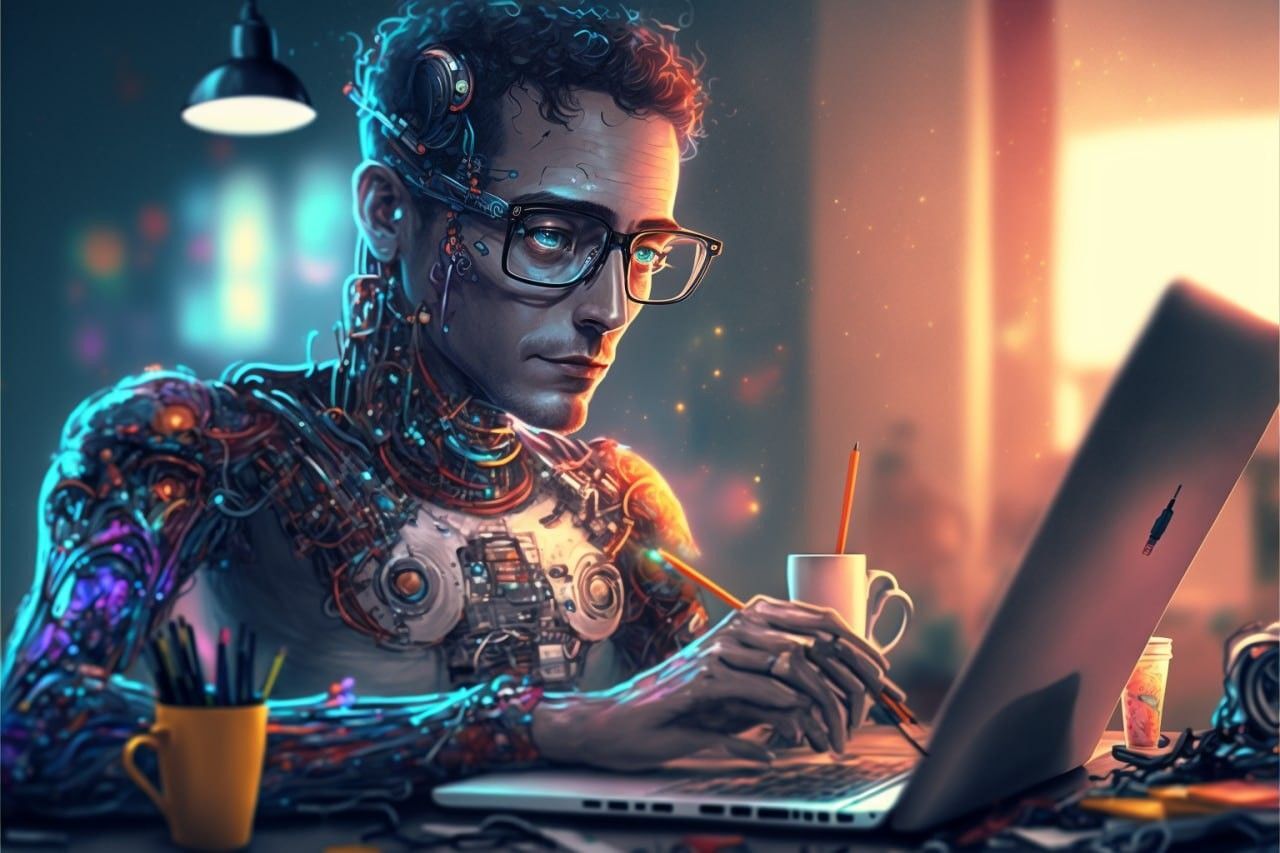Top Trends in Education for Students and Professors

Imagine a world where stepping into ancient civilizations, dissecting complex biological organisms, or solving intricate math puzzles is a breeze.
Wait a minute. It's the reality we're living in!
Earlier, we could count only on books in libraries and classes. Now, education is at your fingertips, no matter where you are. The growth of technology allows people to learn faster, more efficiently, and risk-free.
If you want to get a helicopter view of current trends in education and see how to remain engaged, this article is for you.
Read on to find new ways of contribution to your learning process, discovering core education mainstreams and challenges to consider.
Technology Trends in Education for 2024 and Beyond
1. AR/VR and MR are headliners
Virtual Reality (VR), Augmented Reality (AR), and Mixed Reality (MR), new trends in education, were highly supported by the recent launching of Ray-Ban Meta Smart Glasses and Apple Vision Pro. These gadgets are world-famous for the immersive learning experiences they provide while mixing and fluidly blurring the real and digital worlds. Apple is projected to have shipped 350,000 Vision Pro units in 2024 and 1.48 million in 2025, showing that the demand for the new education tool is fast growing.
With its fully immersive environments, VR technology enables students to wander and interact in 3D worlds. It makes things like biology and history pretty accessible and exciting, allowing you to perceive the educational material in the smallest details.
On the other hand, AR overlays the real world with added digital information to enhance textbooks and classrooms, extending learning opportunities through an interactive experience.
The MR technology blends the real and virtual worlds to develop settings in which the physical and digital objects coexist and intermingle in real time for shared or interactive learning.
An excellent example of VR usage in education is the association between Arizona State University and Dreamscape for the release of Learn Lab. The lab currently applies VR, hand tracking, and haptic feedback in teaching biology, with scores showing an increase of 10% over conventional methods.

2. AI is a proven education assistant
Often compared with the new Internet, the AI democratization boom of 2023 provides vast education opportunities. Today, students use AI to guide one-on-one, tailored learning experiences, get academic support on the go when needed, or even optimize study habits with tools like smart tutors or AI-powered research helpers. ChatGPT 4.0, for instance, has offered plenty of opportunities to learn programming, languages, or any other discipline with AI tutors.
Considering the buzz around this innovation, it obviously became fuel for future trends in education, fostering digitization and a smooth virtual learning experience.
The Georgia Institute of Technology provides a vivid example of how much AI upgrades education. This far-reading school introduced an AI-powered chatbot, Jill Watson, in 2016. The product was developed with IBM's Watson technology and had a 97% accuracy rate, guiding through about 10,000 student questions per semester.
3. Remote-first education preferred
Remote, online, and hybrid learning became a new norm during and after the pandemic. Just like most employees aren't eager to return to the traditional offices, the students don't want to go back to campuses. The numbers speak for themselves:
- 38.2% of the students would opt for online learning;
- 36.7% of respondents prefer on-campus learning;
- 25.1% benefit from hybrid learning.
Curious that about 2/3 of the students had a positive attitude toward online and hybrid learning due to support from educational institutions.
Universities and colleges the world over have caught on to the spread of complete online or hybrid programs that cover dozens of different subjects and degrees for several reasons:
- Online and hybrid learning increase student productivity and participation.
- Students have access to a broader range of resources.
- Due to online & hybrid learning, education institutions can reduce campus maintenance and labor costs.
- And last but not least, remote learning means safety and health protection.
Now, most institutions offer at least one remote course. You can choose from Arizona State University, the University of Pennsylvania, or the Massachusetts Institute of Technology, among others.
4. Soft Skills & STEM Trending in Education
STEM (Science, Technology, Engineering, and Mathematics) is a set of disciplines crucial for people in the digital era. Some new education trends are expected to direct students to soft skill development, which includes communication, teamwork, problem-solving, and adaptability when joining STEM courses. So, STEM & Soft Skills can be officially recognized among current educational trends.
Since it's challenging for tech specialists to develop soft skills, colleges have decided to narrow the gap between technical STEM education and the soft skills employers seek.
For example, the Massachusetts Institute of Technology integrates the development of leadership and communication abilities into its engineering courses. At the same time, Stanford University offers design thinking courses for learners to acquire creative and innovative skill sets required in any professional area.
What are the current trends in teacher education?
Education industry trends are for students only? How about trends in teaching? They are a lighthouse for tutors and professors, helping them deliver information in a form acceptable and preferred by the target audience.
Since educators are the first to try trends in practice, they must keep all the innovations on the radar. Shadowing the mainstream helps tutors support student engagement and ensures that teaching methods are up to date.
If you're here to discover what's new in the tutoring world, we can offer you at least five trends to consider.
Experiential Learning: Share practice, not theory — this is the core teaching trend to consider. Students appreciate the hands-on experience you talk about because it lets them explore the peculiarities of their future work. Therefore, tutors should organize web quests, lab sessions, and field trips to show what's behind the hood of each discipline.
Microlearning: People are now used to quick and simple data sharing. It makes tutors go online and give insights in a short text or video format. Microlearning breaks down content into bite-sized, manageable pieces. You can use it for your classes. This practice helps improve retention and engagement by presenting information in short, focused sessions.
Soft Skills Development: Now, they matter even more than hard skills. Therefore, tutors should be like mentors, psychologists, and friends in one bottle for students. Strive to foster their critical thinking, emotional intelligence, and adaptability alongside academic subjects.
Lifelong Learning: If you demonstrate your desire to learn despite your age and degree, your students will do the same. Here, professors should always work on their education and accumulate specific skills in a matter of days to share them right away.
Decentralized Education Platforms: Blockchain technology in education fosters secure and transparent handling of educational records and achievements, simplifying transfers between institutions and enhancing data ownership. Tutors should join organizations like Studyum to increase awareness and facilitate the transition to new work conditions.
Current Educational Trends Depending on Field: Overview
Software Engineering
- Coding bootcamps and microcredentials: Traditional degree programs have held a monopoly until a coding bootcamp and microcredential came in to supplement them with a focus on practical experience with coding, app, and web development. These educational approaches use accelerated learning in short time frames.
- Artificial Intelligence (AI) and Machine Learning (ML) integration: Subjects related to AI and ML are being inducted into the curriculum, not in just one subject but with the intention of incorporating these subjects into project work to prepare the students for coming advancements in the software engineering field.
- Emphasis on soft skills: Even in the technical professions, the value of teamwork, communication, and problem-solving abilities show increasing recognition. To improve these skills, students often undertake collaborative projects that look quite like the teams from real development courses.
Marketing
- Focus on digital marketing: Since most consumers are now online, marketing courses have increasingly focused on digital strategies, social media marketing, SEO, and content marketing. All marketing students need to get used to digital platforms and analytic tools.
- Real-world projects: Marketing students engage in real-world projects that help them work directly with companies or not-for-profit organizations. Such experience is highly valued as it boosts skills in conducting market research, planning campaigns, and performing them.
- Sustainability: Sustainable marketing practices and ethical considerations are issues that are getting increasing attention from consumers who are becoming more environmentally sensitive. Students need to learn how to develop marketing strategies that are both effective and responsible toward society.
Medical Education
- Simulation-Based Learning: With the help of AR/VR, medical students can safely and competently practice surgical interventions and doctor-patient communications side by side. Simulated learning tools are part of the hands-on experience in medical training without the risk.
- Genomics and Personalized Medicine: The emerging fields of personalized medicine draw on advancements, in which educational programs are urged to fold genomics, biotechnology, and personalized medicine in their curricula. The depth of genetic information and how it can be implemented in patient care is a new development area for all physicians.
- Training in Telehealth: Telehealth services have recently been in briskly increasing demand, more so during the COVID-19 pandemic. Telehealth training has also been made a core component of medical student training. On this account, medical students are taught how to conduct remote consultations, either for patients or with the respective digital health technologies.
Top 4 Current Educational Issues To Overcome
AI in Education
Yes, it’s not a mistake; Artificial Intelligence is among both educational trends and issues.
Integrating Gen AI technologies within the educational framework offers many opportunities and dilemmas as well.
While AI provides greater learning experiences, it has also come with its fair share of issues relating to data accuracy and security. Instead of asking for paper help or diligently working on another case study, some students use this technology to cut corners, thereby missing out on valuable knowledge.
Thus, educational institutions and even state authorities develop policies that define rules for Artificial Intelligence usage.
Digital Divides
The 2024 National Educational Technology Plan highlights three critical divides:
- Digital Use Divide, focusing on enhancing how technology is used in learning;
- Digital Design Divide, following which educators should improve in creating technology-enabled learning experiences;
- Digital Access Divide, addressing the need for equitable access to educational technology and resources.
These points show the ongoing efforts to use technology to improve educational outcomes and access.
Equity and Inclusion
Institutions devise strategies for making education increasingly accessible to underrepresented groups. These strategies may encompass various aspects, such as curricula designed with multiple perspectives and technologies. They ensure that every learner, whoever they are, has an opportunity to learn.
Expansion of Inequality
UNESCO claims that 244M children couldn't start the new school year in 2022. This means at least the same number of people won't apply to colleges and universities in a few years. Inequalities dilate through funding gaps and the impact the pandemic has had on low-income students. Most people still lack a stable Internet connection, which minimizes their ability to access educational resources online.
It means systemic changes must be implemented to ensure equal educational opportunities for all learners. Businesses focus on faster 5G roll-out to provide 100% quality connection worldwide. However, the tech progress isn't enough. Both public and private sectors should work jointly to provide relevant investment and increase awareness to get people back to educational institutions.
Summary
Due to the tech revolution, studying feels like stepping right into a future we used to only dream about. VR, AR, and AI transform classrooms into dynamic, interactive worlds, and remote learning helps maintain a healthy study-life balance.
However, we should consider both current trends and issues in education to get the bigger picture.
Taking advantage of all the benefits technology education trends provide is crucial. But remember that innovations are implemented only to support us, not replace us. Use them thoughtfully, considering knowledge gaining as a core priority.











